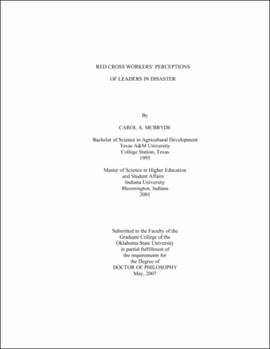| dc.contributor.advisor | Pennington, Penny | |
| dc.contributor.author | McBryde, Carol A. | |
| dc.date.accessioned | 2013-11-26T08:22:20Z | |
| dc.date.available | 2013-11-26T08:22:20Z | |
| dc.date.issued | 2007-05 | |
| dc.identifier.uri | https://hdl.handle.net/11244/6566 | |
| dc.description.abstract | Scope and Method of Study: The purpose of this study was to describe the perceptions of Red Cross workers, both paid staff and volunteers, toward their leaders in disaster emergency response situations. This study utilized Q-methodology to examine the perceptions of Red Cross workers from multiple locations in the United States. Participants were asked to rank order a set of statements about their field leader from most unlike to most like, creating a Q-sort. Each participant's Q-sort was then compared to all other Q-sorts through correlation and factor analysis. Factor analysis produced four distinct patterns of perception or views of leadership. These factors, or views of leadership, are the primary findings of the study. | |
| dc.description.abstract | Findings and Conclusions: This study attempted to answer three research questions. The first research question of this study asked: How do views of leadership vary among Red Cross workers? The analysis of the data showed four distinct views of leadership among Red Cross workers. Each of the four factors represents a unique perspective existing in the population of Red Cross workers and helps to better understand the workers who hold that particular view of leadership. The second research question focused on how Red Cross workers viewed their actual and ideal leader, and the comparison of these two views. In a general way, most people who are working for the Red Cross view their actual and ideal leader the same way. The third research question dealt with the relationship between leadership theory, specifically charismatic leadership theory and transformational leadership theory, to the leadership perspective of Red Cross workers. Both theories help inform an understanding of Red Cross field leadership, but neither theory fully represents the perceptions of Red Cross workers. After these research questions have been explored, the paper offers some conclusions, links to current literature, and recommendations for further research. | |
| dc.format | application/pdf | |
| dc.language | en_US | |
| dc.rights | Copyright is held by the author who has granted the Oklahoma State University Library the non-exclusive right to share this material in its institutional repository. Contact Digital Library Services at lib-dls@okstate.edu or 405-744-9161 for the permission policy on the use, reproduction or distribution of this material. | |
| dc.title | Red Cross workers' perceptions of leaders in disaster | |
| dc.contributor.committeeMember | Weeks, Bill | |
| dc.contributor.committeeMember | Blackwell, Cindy | |
| dc.contributor.committeeMember | Montogomery, Diane | |
| osu.filename | McBryde_okstate_0664D_2279.pdf | |
| osu.accesstype | Open Access | |
| dc.type.genre | Dissertation | |
| dc.type.material | Text | |
| thesis.degree.discipline | Agricultural Education | |
| thesis.degree.grantor | Oklahoma State University | |
